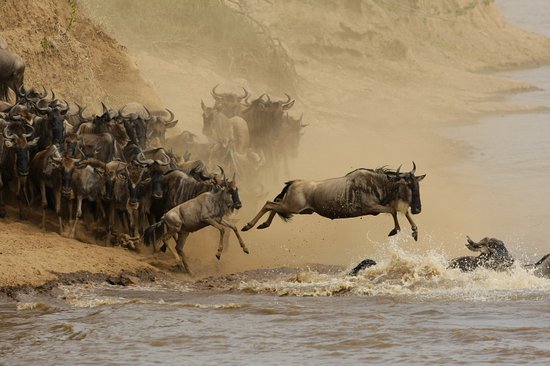The Great Wildebeest Migration is a truly awe-inspiring natural phenomenon that takes place annually in the vast Savannah of the Serengeti in Tanzania and the Masai Mara in Kenya. During this time, over two million wildebeest, zebra, and Thomson’s gazelle embark on a journey to find fresh grazing and watering holes, crossing rivers, facing the risk of predators, and overcoming natural obstacles along the way. If you’re looking for a once-in-a-lifetime experience, a safari to witness the great wildebeest migration is a must.
You can expect to see not just wildebeest but also a variety of other wildlife, including zebras, elephants, lions, and many types of birds. The Great Wildebeest Migration is a natural event that is not to be missed and you can witness it in all its glory while experiencing the beauty of the African wilderness.
January through to March the wildebeest of the southern Serengeti start their calving season. It is estimated that as many as half a million wildebeest calves are born during this period with as many as 8000 being born on any one day. This period sees the start of the first rainy season in the south Serengeti and like most animals in the wild it is always best to give birth at this time as rates of survival are far higher. The south Serengeti is also a great place for the mothers to give birth as the grass here is enriched with high levels of calcium and magnesium which helps with their milk production
April to may is known as the onset of the long rains and the herds start moving towards the central part of the Serengeti in search of fresh grass. They tend to split into various large groups, some beginning to head to the Western Corridor of the Serengeti towards Lake Victoria and others remain in Central and North Central Serengeti around the Seronera River.
In June – mid July, the herds are now split, with the majority in the Western Corridor of the Serengeti by the Grumeti River; where many cross the crocodile infested river, making for some amazing wildlife viewing. The other large herds are now in the North Central Serengeti heading towards the Northern Serengeti and Masai Mara.
By Mid July – October continuing north, some of the smaller herds will be reaching the Masai Mara by as early as late June, early July. The larger, or mega-herd obviously takes a bit longer and generally reaches northern Serengeti / Kenya’s Masai Mara in August. It is over this period that the wildebeest need to cross the Mara River in order to get across the to the lush grass of the Masai Mara. The herds keep crossing at various points of the Mara River and many of these crossing points are in the Serengeti as well as the Masai Mara. It is the Mara River that bears witness to some of the most spectacular crossings of the migration. It is here that the crocodiles keep their heads up waiting for the next meal.
By November – December, they have time spent in the Masai Mara the herds and the short rains begin to head south back into Tanzania. The circle of life is almost complete and the wildebeest begin to return to the mineral rich short grassed plains of the southern Serengeti so they can once again begin their calving season and start the journey again.
Gorilla Expeditions offers amazing gorilla trekking tours to Rwanda, Uganda & DR Congo for unique gorilla watching adventure with the lead of experienced park rangers & Safari guides at affordable prices. We lead gorilla watching expeditions to gorilla trekking destinations in Africa, Volcanoes National Park, Virunga National Park, Bwindi Impenetrable National Park, Mgahinga National Park & Kahuzi Biega National Park for the Eastern Lowland Gorillas which are unique from Mountain Gorillas in the Virunga Massif.
Gorilla trekking is expensive because mountain gorillas are endangered and because of that many people want to see them. The high numbers of tourists interested in observing wild gorillas has forced many governments to raise the price of permits. You can say the principle of demand and supply applies here.
A gorilla permit is a document that allows you access to the gorillas. In Uganda, gorilla permits cost $800 and in Rwanda $1500. A gorilla permit is a requirement for tracking gorillas. You cannot be allowed to take part in the activity without showing your permit to the park authorities.
Gorilla Trekking through steep and slippery Virunga slopes is so strenuous and takes 2-8 hours depending on gorillas’ movements. At least an hour is allocated to the visitors in the presence of the gorilla group.
At 7:00 am local time, breakfast at the lodge will be ready. 30 minutes will be enough for your breakfast and then transfer to the nearby park headquarters where you will be briefed by park ranger on how to carry out gorilla tracking. Hiking on the slippery and muddy Volcanoes slopes with nettles is quite challenging.
The encounter with mountain gorillas erases all the bad memories! You will be allowed to stay with these close relatives of ours (mountain Gorillas) for at least an hour for observation and photography.
Each gorilla family is visited once par day by a group of 8 trekkers who are permitted to spend an hour in their presence. In addition to mountain gorillas, visitors can also see the endangered golden monkeys which are visited on a separate trip that is if in volcanoes national park or Mgahinga national park.


